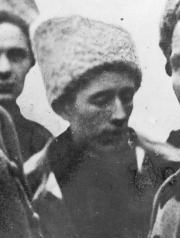Simon Karetnik | |
|---|---|
Simon Karetnik in 1919  | |
| Born | 1893 Huliaipole Yekaterinoslav Governorate Russian Empire |
| Died | November 26, 1920 (aged 26–27) Melitopol Yekaterinoslav Governorate Ukrainian People's Republic |
| Allegiance | |
| Rank | Commander (Атаман) |
| Commands held | Revolutionary Insurrectionary Army of Ukraine |
| Battles/wars | Russian Civil War
|
Simon Mikytovich Karetnik (Ukrainian: Семен Мики́тович Каретник; 1893 – November 26, 1920) was a Ukrainian anarchist and a commander of the Revolutionary Insurrectionary Army of Ukraine (RIAU). He often replaced Nestor Makhno as supreme commander of the Black Army in 1920.[1] Karetnik gained a reputation for his central role in defeating the White Army in Crimea in November 1920.
Biography
In his early life, Karetnik was one of the poorest peasants of Huliaipole, working as a farm labourer. Being an anarchist since 1907, he took part in the Makhnovist movement from its very beginning, as a close companion of Nestor Makhno and Martchenko. In 1917, he became a member of the Black Guards. In 1918 he was elected commander of the battalion headquarters and the Huliaipole detachment. From March to June 1919, he acted as the head of the Berdyansk garrison. From September to December 1919, he was commander of the Huliaipole infantry regiment. [2]
In July 1920 he was elected member of the Council of Revolutionary Rebels of Ukraine and assistant commander. On July 27, 1919, he participated in the assassination of Nikifor Grigoriev in the village of Sentovo. He personally shot Grigoriev's bodyguard when he tried to shoot Makhno. On December 2, 1919, he commanded a group of counterintelligence officers during the execution of Mikhail Polonsky (commander of the 3rd Crimean regiment of the RIAU), who was convicted of plotting a Bolshevik coup in parts of the Free Territory. Karetnik was categorically against the signing of the Military-Political Agreement between the Government of the Ukrainian SSR and the Black Army on October 16, 1920, as he did not believe in the sincerity of the Bolsheviks.
During the operation to occupy Crimea, he was appointed commander of the Crimean corps by the Council of Revolutionary Rebels of Ukraine. On November 8, 1920, the RIAU's Crimean Corps crossed the Sivash and reached the Lithuanian Peninsula in the rear of Pyotr Wrangel's fortifications at Perekop. On November 9, in a battle near Lake Bezymyannoye, Karetnik's Crimean corps defeated the five thousandth horse corps of General Barbovich. He was wounded several times while fighting against the White Army, but on November 13 and 14, 1920, the Crimean Black Army defeated Wrangel's forces on the peninsular and moved upon Simferopol.
On November 23, 1920, after their victory over the Whites, the Crimean corps received an order from Mikhail Frunze, which stated: “All units of the former rebel army located in Crimea should immediately be included in the 4th army, whose Revolutionary Military Council is entrusted with their reorganization ...“ The general meeting of the group refused this, explaining that in peacetime the Crimean Corps was subordinate only to the RIAU headquarters in Huliaipole, and that paragraph 1 of the military agreement was violated by this order. In response to this, on November 24, Karetnik and his group were called to Frunze's headquarters. They hesitated for a long time, and then decided to go, taking precautions and leaving certain comrades in their place. On November 26, 1920, on his way to this meeting, he was captured along with his staff by the Bolshevik troops in Melitopol and executed.[3][1]
References
- ^ a b Volin (1947). "7. The Fate of Makhno and Some of His Comrades. Epilogue". The Unknown Revolution, 1917–1921. Book Three. Struggle for the Real Social Revolution.
- ^ Belash, Viktor (1993). The Roads of Nestor Makhno (PDF). p. 581. ISBN 5-7707-3814-6.
- ^ Arshinov, Peter. History of the Makhnovist Movement (1918–1921). p. 297-298. Retrieved 2019-09-30.